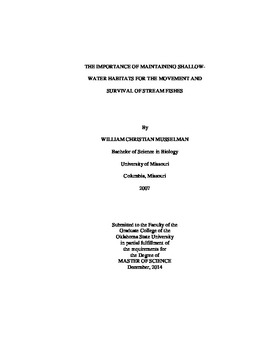| dc.contributor.advisor | Brewer, Shannon K. | |
| dc.contributor.author | Musselman, William Christian | |
| dc.date.accessioned | 2016-01-20T15:44:47Z | |
| dc.date.available | 2016-01-20T15:44:47Z | |
| dc.date.issued | 2014-12-01 | |
| dc.identifier.uri | https://hdl.handle.net/11244/25691 | |
| dc.description.abstract | Environmental flows are important for the conservation of stream biota. Although a range of flows are necessary for the persistence of aquatic species, minimum flow standards are often the most basic component. The objectives of this study were to determine the effects of low flows on habitat availability, habitat connectivity, and water temperature and assess the consequences to stream fish. Stream drying disproportionately affects shallow-water habitat availability in streams. Using a wetted-area approach, I found backwaters, riffles, and runs experienced the greatest loss of area in this study with decreasing discharge. Fish assemblage relationships with channel units were quantified using ordinations. Shallow-water channel units (i.e., riffles, runs, vegetated edgewaters) structured much of the fish assemblage in Barren Fork Creek, particularly benthic fishes. Additional fluvial specialists (e.g., cardinal shiner Luxilus cardinalis) were found in the Illinois and Flint Creek and related to higher-velocity habitats. Diel shifts in habitat use were observed in all streams suggesting connectivity between channel units to be important for fish. Continuous recaptures over about 50 days of four PIT-tagged species in Flint Creek were analyzed using a multistate model in MARK. I found survival probabilities of cardinal shiner and orangethroat darter Etheostoma spectabile were related to daily discharge. More importantly, transition probabilities were related to daily discharge for three species (i.e., cardinal shiner, orangethroat darter, and slender madtom Noturus exilis). Transition probabilities were near zero at approximately 0.43 - 0.57 m3/s suggesting reduced connectivity. Maximum mean daily water temperatures were: 31.63 ˚C and 29.55 ˚C for the Illinois River and Flint Creek, respectively. I used SSTEMP to model a 50% reduction in discharge that resulted in a 0.32 ˚C and 0.13 ˚C decrease in maximum water temperature in each of the two streams. Temperature modeling of Barren Fork Creek was difficult to interpret because of extreme low flows. Increasing discharge in the Illinois River and Flint Creek showed only minimal reductions in risk of exceeding critical thermal maximum (CTM) for fishes. Flint Creek, however, appeared to offer thermal refugia for many species. My results indicated a discharge of 0.57 m3/s was a critical threshold for functional connectivity in Flint Creek. Based on channel morphology, I would expect restricted movements to occur above this threshold in the Barren Fork Creek and Illinois River. | |
| dc.format | application/pdf | |
| dc.language | en_US | |
| dc.publisher | Oklahoma State University | |
| dc.rights | Copyright is held by the author who has granted the Oklahoma State University Library the non-exclusive right to share this material in its institutional repository. Contact Digital Library Services at lib-dls@okstate.edu or 405-744-9161 for the permission policy on the use, reproduction or distribution of this material. | |
| dc.title | Importance of Maintaining Shallow-water Habitats for the Movement and Survival of Stream Fishes | |
| dc.type | text | |
| dc.contributor.committeeMember | Grabowski, Timothy B. | |
| dc.contributor.committeeMember | Tobler, Michael | |
| osu.filename | Musselman_okstate_0664M_13772.pdf | |
| osu.accesstype | Open Access | |
| dc.description.department | Natural Resources and Ecology Management | |
| dc.type.genre | Thesis | |
